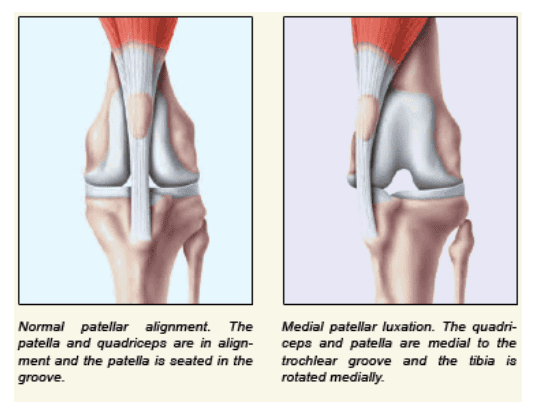Luxating Patella
The patella (knee cap) is a small bone within your pet’s knee that sits within a small groove (the patella groove) on the large long bone called the femur. The muscular attachments to the patella and the patella attachments to the bones of the leg (the femur and the tibia), allow the patella to act as a hinge so that your pet can bear full weight on their hind legs. With patella luxation, the small bone can move in and out of its groove causing the following signs of disease:
- Acute inability to use one limb
- The affected limb may temporarily lock into place
- Your pet may temporarily lose the ability to bear weight on the limb altogether
With chronic disease, arthritis and other joint injuries can occur, causing severe pain when standing on the leg or moving the joint at all. Patellar luxation can affect one or both hind legs.
Cause: Luxating patellas are a congenital abnormality in the formation of the patella groove, the position of the tibia and femur in respect to the patella or the attachments of the muscle to the bodies on the patella. Patella luxation is graded from I-IV dependent on the severity of the disease:
- Grade I (Mildest form): Here the patella moves out of the groove when pressure is placed on the kneecap, but the patella quickly moves back into position.
- Grade II: The patella can be manually removed from its groove and the kneecap will remain out until it is placed back in or if the animal flexes their leg.
- Grade III: The patella spontaneously moves out of its groove but will replace itself when replaced manually or if the animal extends or flexes its knees.
- Grade IV (Most severe): The patella freely moves out of its groove and does not reposition itself normally.
Patella luxation occurs often in dogs but is rare in cats. It has been associated more commonly with miniature or toy breeds of dogs, especially in Yorkshire Terriers, Pomeranians, Pekingese, Chihuahuas and Boston Terriers. It tends to be more prevalent in females. Clinical signs are typically seen shortly after birth.
If severe luxating patellas are not properly repaired, chronic arthritis and further joint injury (i.e. anterior cruciate ligament damage…) may occur making your pet severely painful and requiring more serious surgery that may leave the affected limb with decreased function.
Diagnosis:
Since this disease produces lameness that could be caused by other diseases (e.g. anterior cruciate ligament rupture, fractures, trauma, and other congenital abnormalities), you veterinarian may suggest the following diagnostic tests:
- Radiographs (x-rays): Radiographs allow your veterinarian to assess affected limbs for possible fractures, changes in growth plates, joints bone or cartilage.
- Treatment: Treatment is based on the presentation of the animal and the severity (grade) of the disease.
- Medications: These are focused on decreasing inflammation and pain within the joint.
- Diet: Your veterinarian may suggest placing your pet on a controlled calorie diet to help them loose weight to make them less painful on the affected leg.
- Surgery: Depending on the severity of the luxation and the persistence of lameness, your veterinarian may suggest a surgical repair. Surgery is dependent on how severe the luxation and the congenital changes in the bones and muscles that have predisposed the luxation to occur. Surgery can involve deepening of the patella groove, repositioning the attachment of the patella onto the tibia, tightening of the tissue around the kneecap, as well as other procedures.
Please contact us if:
- There is continued weakness, decreased ability to exercise or pain.
- Your pet continues to limp or not use the leg at all
- The other hind leg begins to show sensitivity
- There is any overall change in the health of your pet.

